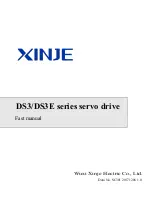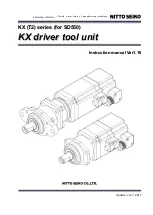
JT550 Series Inverter Manua
l
Chapter 7 Maintenance and Troubleshooting
- 123 -
2) Long period of storage may result in the deterioration of electrolyte capacitance. Therefore, it is
necessary to power it on in 2 years and have it stay on for at least 5 hours. Input voltage must
slowly rise to the set value using a voltage regulator.
8.2 Warranty
1) Warranty may only apply to this inverter itself.
2) This Limited Warranty covers any defects in material or workmanship under normal use during
the Warranty Period (please refer to the bar code on the product for the manufacture date) at no
charge. After the Warranty Period, a reasonable charge will be applied.
3) During the Warranty Period, the following actions will result in a charge:
a
)
User does not follow the instruction manual and causes damage to the product;
b
)
Damage caused by fire, flood and abnormal voltage;
c
)
Damage caused by using the product improperly.
4) Any charge is subject to the company’s standard. If an agreement is made, the agreement is
prioritized.
8.3 Faults and Solutions
The JT550 provides a total of 24 pieces of fault information and protective functions. After a fault
occurs, the inverter implements the protection function, and displays the fault code on the operation
panel (if the operation panel is available).
Before contacting Juditech for technical support, you can first determine the fault type, analyze
the causes, and perform troubleshooting according to the following tables. If the fault cannot be
rectified, contact the agent or Juditech. Err22 is the inverter hardware overcurrent or overvoltage signal.
In most situations, hardware overvoltage fault causes Err22.
Name
Display
Possible Causes
Solutions
Overcurrent
During
Acceleration
Err02
1: Inverter’s output circuit is
grounded or short;
2: Control mode is vector and no
parameters identification;
3: Acceleration time is too short;
4: Voltage is too low;
5: Initiate start on the motor while
it is still running;
6: Sudden load added while
accelerating;
7: The model of inverter is too
small;
8: The braking resistor is short.
1: Eliminate the peripheral failure;
2: Initiate the identification of
motor parameters;
3: Increase acceleration time;
4: Adjust the voltage to the normal
range;
5: Choose rotational speed tracking
start or start it after the motor stops;
6: Cancel the sudden load addition;
7: Use the inverter that has a higher
power level;
8: Check if the braking resistance is
normal
Overcurrent
During
Deceleration
Err03
1: Inverter’s output circuit is
grounded or short;
2: Control mode is vector and no
parameters identification;
3: Deceleration time is too short.
4: Voltage is too low;
5: Sudden load added while
decelerating;
6: No braking units or braking
resistors added
7: The braking resistor is short.
1: Eliminate the peripheral failure;
2: Initiate the identification of
motor parameters;
3: Increase deceleration time;
4: Adjust the voltage to the normal
range;
5: Choose rotational speed tracking
start or start it after the motor stops;
6: Cancel the sudden load addition;
7: Check if the braking resistance is
normal.














































